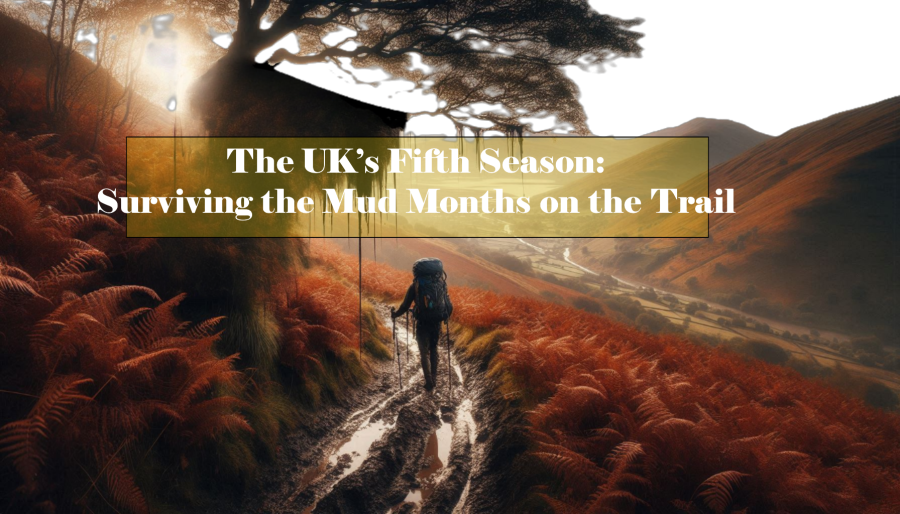Table of Contents
Some links on posts are affiliate links and will earn us a commission from qualifying purchases
It’s November. The last leaves have given up and are plastered to the ground, the sky is a shade of grey that Dulux probably calls “Drizzle”, and every single step makes that unmistakable squelch sound. Congratulations – you’ve entered the UK’s unofficial fifth season: the mud months.
Mud is more than just a messy nuisance. It slows you down, drains your energy, and sometimes makes you wonder why you ever took up walking as a hobby. And yet, these months also offer some of the most character-building hikes you’ll ever do.
If you can survive January in the British countryside, ankle-deep in sludge, you can handle anything the outdoors throws at you. Let’s talk about why mud matters, how to beat it with the right gear, and how to laugh about it when you inevitably end up sitting in it.
Why Mud Season Matters
We live in a country that has a special talent for mud. Rain falls generously, our clay-heavy soils cling onto every drop, and our most popular footpaths see thousands of boots a week churning them into porridge. The result? You don’t just walk during mud season – you wade.
It changes everything. Your pace slows to a crawl, and you spend more energy dragging those lead-weighted boots along than you would on a dry summer hill climb. Every extra kilo of mud stuck to your soles is like adding a small dumbbell to each foot – and over ten miles, you feel it. Then there’s the risk factor. Mud hides ruts and stones, which is a problem if you’d prefer to avoid an impromptu ankle-twisting session.
And let’s be honest, mud does a number on your morale too. A steep climb is over once you reach the top – but miles of relentless sludge feel endless. You start bargaining with the weather gods, promising to recycle more plastic if only the trail will firm up a bit.
Where Mud Hits the Hardest
Not all trails are equal when it comes to mud. Lowland paths through farmland can be the worst – especially if livestock has been at work churning it up. Suddenly, you’re not just dealing with mud, you’re dealing with a special blend of mud-plus-mystery-organic-material.
Popular areas like the Peak District valleys, the approaches to Lakeland fells, and sections of the South Downs Way can get particularly gloopy. If you’re tackling a long-distance path like the Pennine Way or Coast to Coast outside of summer, you may find yourself playing a never-ending game of “step on the next patch of grass that looks least like quicksand”.
I once misjudged a patch of “innocent-looking” mud on the Wealdway and ended up losing my entire boot to it. There I was, standing in one sock, balancing on one leg like a flamingo, while my walking buddy tried to fish the boot out with a stick. We got it back – eventually – but I had to walk the next two miles with one foot twice as heavy as the other because of the mud packed inside.
Knowing where the worst sections are means you can plan accordingly – or at least mentally prepare yourself for the boggy battle ahead.
Gear That Actually Helps
This is where your kit earns its keep.
Start with footwear. Waterproof boots are your best friend when things get mucky – they keep your feet dry (mostly) and give you some much-needed ankle support when the ground is slippery. Trail shoes are lighter and dry faster, but you’ll end up with wet socks sooner and may miss that bit of extra stability.
Gaiters deserve a mention here – they might not be glamorous, but they’re lifesavers when it comes to keeping mud, water and small farms’ worth of slurry out of your boots. Once you try them, you won’t go back.
Poles are another secret weapon. They give you balance when the trail is acting like an ice rink and let you probe the ground ahead before you commit to that next step.
And when you get home, don’t just leave your boots caked in mud. Mud is leather’s worst enemy. Give them a good brush, rinse with lukewarm water, and let them dry slowly – not next to the radiator unless you enjoy cracked leather and ruined waterproofing.
Mindset and Strategy
Beating the mud isn’t just about kit – it’s about how you approach the day. First, slow down. You won’t be setting personal bests in January, so plan shorter routes and give yourself more time to enjoy (or endure) the journey.
Choose routes with harder ground where you can. Gravel tracks, rocky ridges and old drovers’ roads are all kinder on morale.
And perhaps most importantly – laugh about it. Swap stories with your walking companions, take a photo of the muddiest section, and lean into the absurdity of the situation. Every slip and near-miss becomes a good tale once you’re back in the pub.
Seasonal Timing and Alternatives
Mud season usually peaks from late November through early spring – with February often the worst offender.
If you fancy avoiding the worst of it, look at coastal paths, which often drain better, or pick upland ridges that stay firmer underfoot. Forestry tracks can also be a good option – they’re usually better drained and offer some shelter from winter wind.
Alternatively, use the mud months as training. They build strength, balance and mental toughness – all of which will make summer hikes feel like a walk in the park. Literally.
Final Thoughts
Mud is part of the deal when you’re a UK walker. It slows you down, gets you dirty, and tests your patience – but it also makes you tougher. Think of it as nature’s obstacle course.
So next time you find yourself ankle-deep and muttering under your breath, remember you’re not just trudging through sludge – you’re becoming the kind of hiker who can handle anything. Now lace up those boots, strap on the gaiters, grab your poles and embrace the squelch. You might even enjoy it.
Recent Posts
Additional Winter Hiking Gear: Essential Items to Stay Safe and Warm
Winter hiking is an exhilarating experience that can be enjoyed by anyone, but it requires additional gear to keep you safe and comfortable in the cold weather. In addition to the basic gear required...
Winter Hiking Clothing Tips: Stay Warm and Comfortable on the Trail
When winter arrives, many hiking trails become covered in snow and ice, creating a winter wonderland for hikers. However, hiking in cold weather requires a different approach to clothing. Wearing the...


